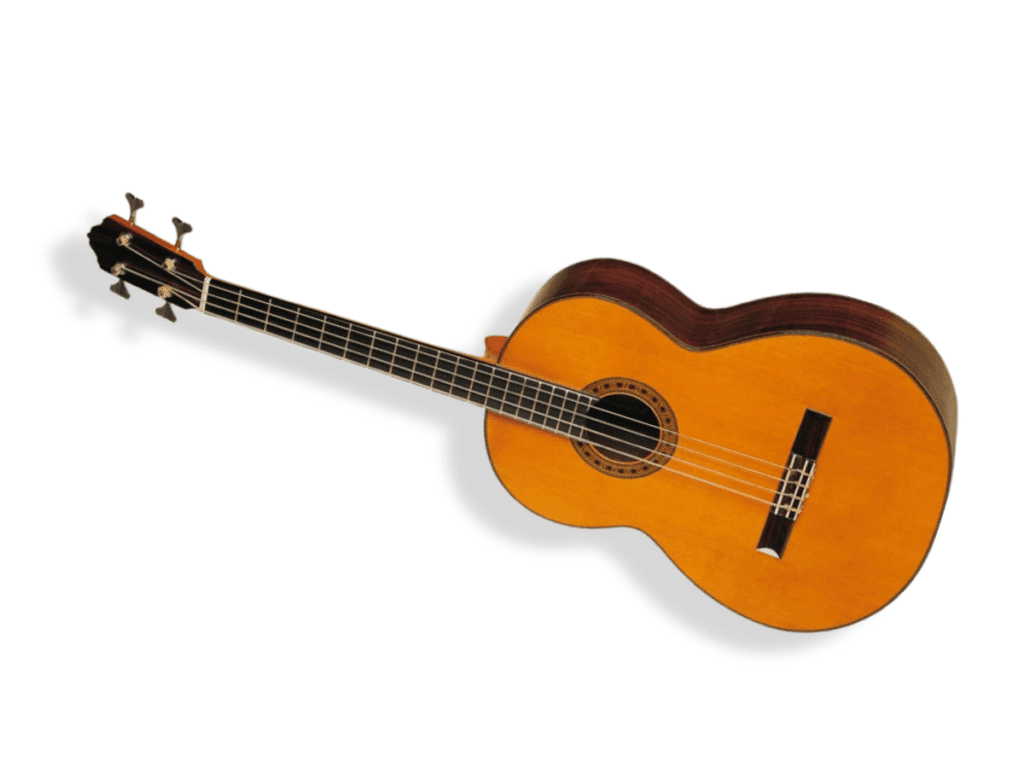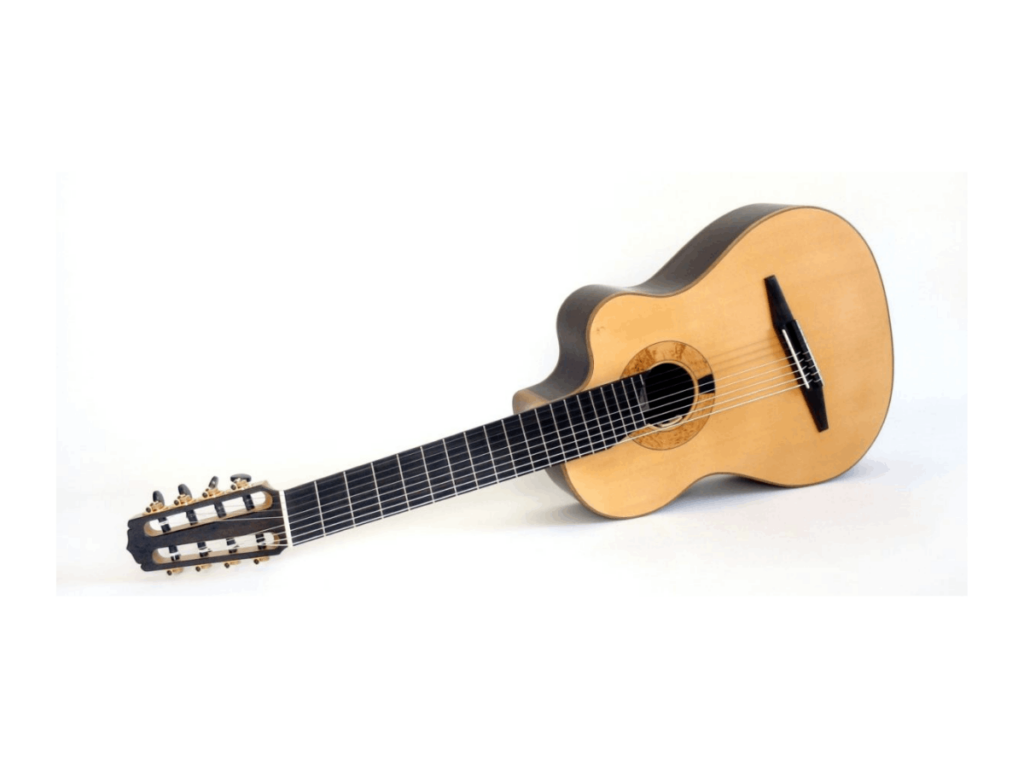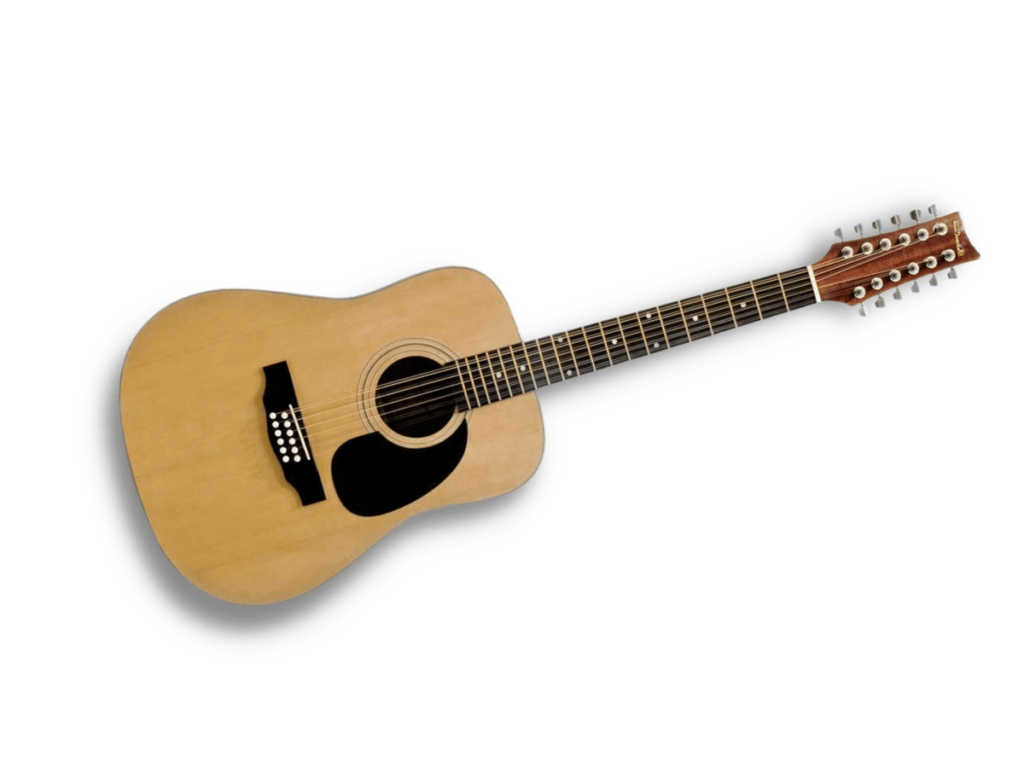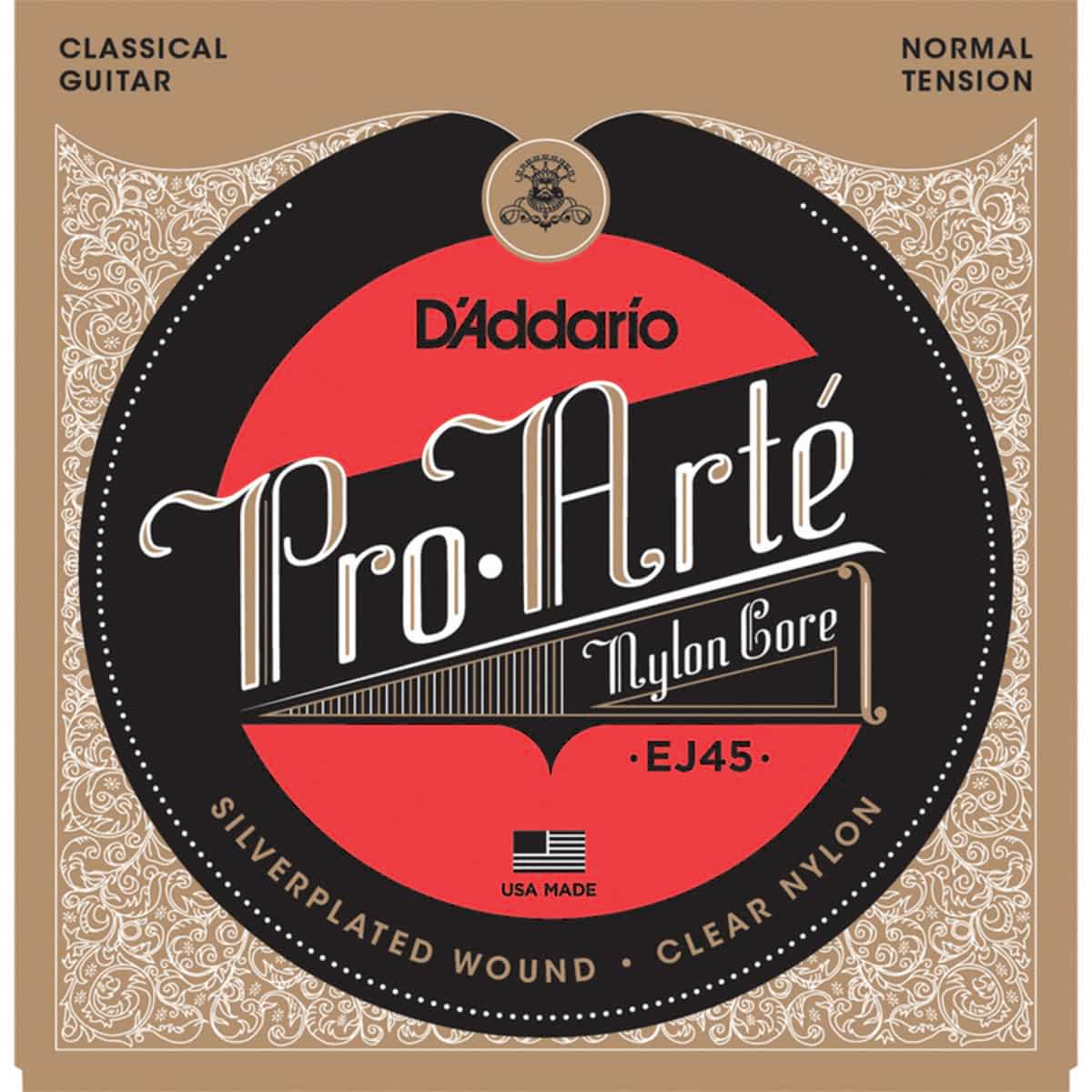Best
Classical Guitar Strings for Beginners
-
Overall: Clear and warm tone, made with great quality by Fender
-
Best Feature: String gauges .028 .029 .032 .035 .040 .043
-
TedScore™: 7/10
Best
Classical Guitar Strings Overall
-
Overall: Reliable classical tone - D'Addario's best-selling, normal tension set
-
Best Feature: Superb treble string intonation and consistency
-
TedScore™: 9/10
Best Classical
Guitar Strings for Intermediate
-
Overall: Strings that are wound in silver-plated copper
-
Best Feature: Exceptional feel thanks to quality construction
-
TedScore™: 9/10
Before you start shredding those strings again, let’s take a moment to appreciate the beauty and complexity of the classical guitar.
This elegant instrument has captivated audiences for centuries, and one of its defining features is the number of strings.
So, how many strings does a classical guitar have? The answer may surprise you!
In this article, we’ll explore the history and anatomy of the classical guitar and reveal the secrets behind its strings.
Whether you’re a seasoned musician or a curious beginner, get ready to dive into the world of classical guitar and discover the magic of its strings!
Origin and Evolution of the Classical Guitar

The classical guitar can trace its roots back to the 16th century. During this time, the lute was a popular European instrument, often used to accompany singers and dancers.
The lute had a pear-shaped body and a long neck, and it was played with a plectrum.
Over time, the lute evolved into the modern guitar. In the 18th century, the guitar began to replace the lute as the preferred instrument for accompanying singers and dancers.
Guitar makers in Spain, such as Antonio de Torres, began developing new guitar designs, making it louder and more versatile.
By the 19th century, the modern classical guitar had emerged. This guitar had six strings and a larger body than the guitars of previous centuries. It was also played with the fingers rather than a plectrum.
Differences Between Classical Guitars and Other Types of Guitars

Classical guitars are different from other types of guitars in several ways.
Firstly, they’re typically made with nylon strings, which produce a softer, warmer sound than steel strings.
Classical guitars have wider necks and flatter fingerboards, making playing complex chords and fingerstyle techniques easier.
Another key difference between classical guitars and other guitars is how they are played.
Classical guitarists use “fingerstyle” technique, plucking the strings with their fingers rather than strumming them with a pick.
This allows for greater control over the sound of the guitar, and it’s often used to play classical music and other genres, such as flamenco and bossa nova.
The Different Parts of a Classical Guitar

Importance of the Strings in Producing Sound
A classical guitar consists of several parts, each of which plays an important role in the sound production. Here’s a breakdown of the different parts of a classical guitar:
The Headstock
The Neck
The Fretboard/Fingerboard
The Bridge
The Tail
The strings of a classical guitar are one of the most essential parts of the instrument. They’re responsible for producing the sound you hear while playing the guitar.
The strings of a classical guitar are made of nylon or gut, which gives them a warm, mellow tone.
The strings are attached to the bridge at the bottom of the guitar, and are anchored at the tail.
Plucking or strumming the strings causes them to vibrate, creating sound waves that resonate through the guitar’s body and sound hole.

Number of Strings on a Classical Guitar

Traditional Number of Strings on a Classical Guitar
Many wonder, “How many strings does a guitar have?”
Traditionally, a classical guitar has six strings. These strings are typically made of nylon, and are tuned to the following notes (from lowest to highest): E, A, D, G, B, E.
This six-string configuration is sometimes called a “six-string guitar” or “six-string classical guitar.”
Common Variations in the Number of Strings
While six strings is the traditional number for a classical guitar, there are a few common variations you may come across:

Four-string classical guitar: Some classical guitars have only four strings, rather than six. These guitars are sometimes used in Latin American music and are typically tuned to the following notes (from lowest to highest): G, C, E, A.

Eight-string classical guitar: An eight-string classical guitar has two additional bass strings, which are typically tuned to F# and C#. This configuration is sometimes used in Brazilian music.

12-string classical guitar: A 12-string classical guitar has six pairs of strings rather than six individual strings. Each pair of strings is tuned to the same note, but one string is slightly higher in pitch than the other. This configuration can create a richer sound than a traditional six-string guitar.
Types and Tuning of Classical Guitar Strings
Materials Used in Classical Guitar Strings

Classical guitar strings come in various materials, including nylon, gut, and metal.
Nylon strings are the most common and are made of a single transparent nylon string for the trebles and hundreds of individual strands of nylon wrapped with silver or bronze-plated copper thread for the basses.
On the other hand, gut strings are made from the intestines of sheep or cows and produce a warm, mellow sound. Metal strings are not commonly used on classical guitars due to their harsh and bright sound.
Different Tension Levels for Various Playing Styles

Classical guitar strings come in different tension levels, affecting the guitar’s sound and playability.
High-tension strings require more pressure to play and produce a louder and brighter sound, making them suitable for solo performances and flamenco-style playing.
On the other hand, low-tension strings are easier to play and produce a softer and warmer sound, making them ideal for beginners and classical-style playing.
Tuning Methods for the Strings

The six strings of a classical guitar are usually tuned to the following notes: E, A, D, G, B, and E. This is known as standard tuning or E standard tuning.
Depending on the musical piece, specific tunings may be required, and guitar notes are commonly notated one octave above their actual pitch.
To tune the guitar, each string is adjusted using the tuning pegs until it produces the correct frequency.
Pros and Cons of Different String Configurations

Benefits of Traditional Six-String Configuration
The traditional six-string configuration is the most common setup for classical guitars. It provides a balanced tone and is the easiest to learn for beginners.
One of the benefits of the six-string configuration is that it allows for a wide range of musical expressions.
It’s also the most widely available configuration, with most guitar manufacturers producing six-string classical guitars.
Advantages and Disadvantages of Additional Strings
Some classical guitars also have additional strings beyond the traditional six-string configuration.
These additional strings can provide an extended range and tonal options. For example, a seven-string guitar adds a low B string, which can be helpful for bass notes and chords.
However, additional strings can make the guitar more difficult to play and require more complex fingerings.
They can also be more expensive and less widely available than traditional six-string guitars.
Considerations for Choosing the Right String Configuration
When choosing a string configuration for your classical guitar, consider your playing style and musical preferences.
A traditional six-string guitar may be the best option if you’re a beginner. If you’re an experienced player looking for extended range and tonal options, a guitar with additional strings may be worth considering.
It is also important to consider the type of music you’ll be playing. For example, a traditional six-string guitar may be the best choice if you primarily play classical music.
However, if you play more modern styles of music, such as djent, an extended-range guitar with additional strings may be more suitable.
Our Pick of the Best Classical Guitar Strings

PERFECT FOR: live performances, studio recording, and classical guitar playing
FEATURES: Provides superb treble string intonation and consistency
OTHER INFO: Comes with semi-polished bass strings for a minimal fret noise
D'Addario EJ45 Pro-Arte Nylon, Normal Tension Strings
When you check the price above, you’ll see there are loads of great places to buy this item. Our personal favorite is Gear4music.
It is the largest music retailer in the UK and fast becoming the most respected online music shop in the US too. Their customer service is excellent, they have competitive prices, really fast shipping, and usually have the longest guarantee.
Most professional musicians use Gear4music, so there is no reason why you shouldn’t too!
- Offers a balance of rich tone, comfortable feel and dynamic projection
- Reliable and long-lasting
- Sealed in eco-friendly, anti-corrosion packs
- Considered one of the best nylon guitar strings available
- May not be suitable for more aggressive playing styles
The professional musician who wrote this article combined many things,
from the product build, manufacturer’s reputation through to feedback
from other users, to create our famous TedScore™.

DESIGNED FOR: Beginners
STRING TENSION RATING: Normal
FEATURES: String gauges .028 .029 .032 .035 .040 .043
FENDER 100 CLASSICAL NYLON CLEAR, SILVER TIE END STRINGS
When you check the price above, you’ll see there are loads of great places to buy this item. Our personal favorite is Gear4music.
It is the largest music retailer in the UK and fast becoming the most respected online music shop in the US too. Their customer service is excellent, they have competitive prices, really fast shipping, and usually have the longest guarantee.
Most professional musicians use Gear4music, so there is no reason why you shouldn’t too!
- Clear and warm tone
- Made by Fender
- You pay slightly for the name
The professional musician who wrote this article combined many things,
from the product build, manufacturer’s reputation through to feedback
from other users, to create our famous TedScore™.

DESIGNED FOR: Beginner To Experienced guitarists
OTHER INFO: Gauge: 0.28-0.44
FEATURES: Wound in silver plated copper for a smooth
D'Addario XT SPC Classical Strings, Normal Tension
When you check the price above, you’ll see there are loads of great places to buy this item. Our personal favorite is Gear4music.
It is the largest music retailer in the UK and fast becoming the most respected online music shop in the US too. Their customer service is excellent, they have competitive prices, really fast shipping, and usually have the longest guarantee.
Most professional musicians use Gear4music, so there is no reason why you shouldn’t too!
- High-quality materials for improved sound and feel
- Well-balanced tone with normal tension
- Durable strings
- For more experienced players, it may not be customized enough
The professional musician who wrote this article combined many things,
from the product build, manufacturer’s reputation through to feedback
from other users, to create our famous TedScore™.

DESIGNED FOR: Intermediate to Advanced Players
STRING TENSION RATING: Low in Bass Strings, Regular in Treble
FEATURES: A variety of tensions, to make your guitar sound better than ever
AUGUSTINE CONCERT LOW TENSION
When you check the price above, you’ll see there are loads of great places to buy this item. Our personal favorite is Gear4music.
It is the largest music retailer in the UK and fast becoming the most respected online music shop in the US too. Their customer service is excellent, they have competitive prices, really fast shipping, and usually have the longest guarantee.
Most professional musicians use Gear4music, so there is no reason why you shouldn’t too!
- Top-quality strings for your classical guitar
- Exceptional feel thanks to quality design
- Warm and rich with low-tension bass strings
- A little pricey
The professional musician who wrote this article combined many things,
from the product build, manufacturer’s reputation through to feedback
from other users, to create our famous TedScore™.

DESIGNED FOR: Beginners to Professional Players
STRING TENSION RATING: Normal/ Medium Tension
FEATURES: Silver-Plated Wound Basses
LaBella 2001 Silverplated Classical Guitar String
When you check the price above, you’ll see there are loads of great places to buy this item. Our personal favorite is Gear4music.
It is the largest music retailer in the UK and fast becoming the most respected online music shop in the US too. Their customer service is excellent, they have competitive prices, really fast shipping, and usually have the longest guarantee.
Most professional musicians use Gear4music, so there is no reason why you shouldn’t too!
- Easy vibrato
- Responsive and sensitive strings
- Warm sound and bright sound with great sustain
- Wallet-friendly price tag
- None
The professional musician who wrote this article combined many things,
from the product build, manufacturer’s reputation through to feedback
from other users, to create our famous TedScore™.
Maintenance and Care of Classical Guitar Strings
Proper Cleaning Techniques for Prolonging String Life
Cleaning your strings regularly can help prolong their life. Sweat, dirt, and oil from your fingers can accumulate on the strings, leading to corrosion and rust.
To clean your strings, use a soft cloth or microfiber towel to wipe them down after each use. You can also use a string cleaner or lubricant to remove any dirt or grime from the strings.
Tips for Preventing String Breakage and Maintaining Optimal Sound Quality
String breakage is a common problem that can occur when playing the guitar. Here are some tips to help you prevent string breakage and maintain optimal sound quality:

Classical guitars typically use nylon strings, while electric guitars use metal strings. Acoustic guitar strings are typically nylon or steel. Make sure you are using the right type of strings for your guitar.
Over time, strings can lose their tone and become dull. Replace your strings every 3-6 months, or more frequently if you play regularly.
Stretching your strings before playing can help prevent them from going out of tune and breaking. To stretch your strings, gently pull on each string while tuning it up to pitch.
Changes in temperature and humidity can cause your strings to expand and contract, leading to tuning and sound problems. Keep your guitar in a stable environment to prevent these issues.
How Many Strings Does A Classical Guitar Have
Summary
The classical guitar’s six strings may seem simple, but they hold a world of complexity and beauty.
Whether you’re a fan of classical music or a rock and roll lover, the classical guitar is a timeless instrument that deserves our attention and appreciation.Both types of guitar are considered Acoustic guitars, but Classical models use nylon strings while the more modern instruments, known as Acoustic guitars, use steel strings.
The two string types have distinct feels and produce different sounds, with nylon strings being thicker and producing a mellower tone. So, the next time you pick up a guitar, take a moment to marvel at its six strings and all the wonders they hold.
And who knows, maybe you’ll be inspired to create your masterpiece and become the next guitar hero!
Before you go…
Are you in the market for a new classical guitar? Look no further than our list of the Top 15 Best Classical Guitars!
From the number of strings to the wood quality, these guitars will impress even the most discerning musicians.
FAQ's
Classical guitars typically have nylon strings, a wider neck, and a more mellow and warm sound suited for playing classical and flamenco music.
Acoustic guitars typically has steel strings, a narrower neck, and a brighter and louder sound suitable for various genres such as, folk music, rock, and pop.
A standard classical guitar typically uses six strings. However, in some cases, there are variations such as seven or ten-string classical guitars, but they’re less common.
Its construction and sound characteristics define a classical guitar.
It typically has a wide neck and a flat fingerboard, nylon strings, and a soundboard made of spruce or cedar, producing a mellow and rich tone ideal for playing classical music.
Classical guitars do not necessarily only have 12 frets. However, some traditional designs might have a limited number of frets as classical music players often focus on the lower positions of the neck.
The wide neck can make reaching higher frets challenging, so fewer frets may be included to accommodate classical guitarists’ playing styles and repertoire.
The guitar with the most strings is typically the harp guitar, which can have up to 12 or even more strings.
This unique instrument combines a traditional guitar body with additional strings that run parallel to the main strings. Harp guitars are often used in orchestras and ensembles to provide a unique and ethereal sound.
Classical guitar strings are typically made of nylon or other materials. The treble strings are usually made of varying gauges of nylon, while the bass strings may have a nylon core wound with metal (typically silver-plated copper) or synthetic materials.
















While the article provides an extensive overview on classical guitar strings, it fails to address the historical evolution of string materials, especially moving from gut to nylon, which significantly influenced the classical guitar’s sound character. Incorporating this information would offer readers a more comprehensive understanding of their instrument’s capabilities and heritage.
I’m particularly fascinated by the segment discussing the different parts of a classical guitar and their historical evolution. It’s intriguing how these developments not only shaped the instrument’s physical attributes but also its sound and the way it’s played. This article by Lewis Turner offers a comprehensive view, providing a deeper understanding of the classical guitar beyond just its musical capabilities. It’s a reflection of cultural shifts across periods, showcasing the instrument’s adaptability and enduring appeal. Would love to see more articles delving into similar historical perspectives on other instruments.
Was looking into expanding my playing into classical guitar, and this article gave a good intro. Interesting to see how maintenance and care differ from what I’m used to with steel-string guitars. Curious about how these differences affect the sound and playability over time.
honestly, does all these fancy strings setup even make a difference? been playing my old guitar with whatever strings i find on sale, and it sounds just fine. sounds like a bunch of marketing fluff to me.
I found the parts discussing the string materials and tension levels particularly useful as I’m still trying to find the right strings for my playing style. Could Lewis Turner or anyone else recommend strings that are good for beginners but also offer quality sound?
Thanks, MelodyGuru! I’ll give those a try.
Sophie L., I recommend starting with a medium tension nylon string. They’re easier on the fingers for beginners and still provide a rich sound.
While I commend the effort to explain string materials and tensions, I believe you’ve oversimplified the relationship between string tension and playing style. String choice is highly subjective and influenced by a multitude of factors beyond just playing style, such as the guitar’s build, the player’s touch, and desired tone. A deeper dive into this topic might provide more value to novices trying to understand the nuances of their instrument.
I just got my first classical guitar, and this article is a goldmine! I had no idea there were so many considerations for the strings. Thanks for shedding light on the varieties and their benefits.
Welcome to the club, Miriam! Wait till you dive into tuning methods; it gets even more interesting.
is it weird to go from punk to classical? kinda feeling like im betraying my roots here lol.
hey, does the number of strings change the way you gotta tune the guitar or what? always thought all guitars were kinda the same deal
more strings, more problems lol
Hey Lewis Turner, quick q about the string tension part: does playing style heavily influence what tension you should go for, or is it more of a personal comfort thing? Cheers!